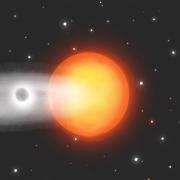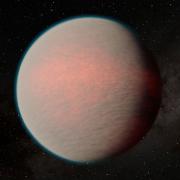Researchers using NASA’s James Webb Space Telescope have glimpsed tantalizing new details about what it’s like at the boundary of a tidally locked planet—that is, one where half of the planet is always exposed to its star, while the other is always shrouded in darkness.
A group of scientists, including several from the University of Chicago, studied a giant planet known as WASP-39 b that orbits a star about 700 light-years away from Earth. This planet doesn’t spin constantly like Earth does; one half of the planet experiences a constant daytime and the other is in constant nighttime.
The powerful telescope allowed the scientists to get the most detailed look yet at the conditions in the thin twilight boundary where the day side and night side meet. They were able to discern a temperature difference even within this narrow boundary; half of the boundary zone is significantly hotter than the other half.
This temperature difference is evidence for powerful winds that sweep across the boundary at thousands of miles per hour. The researchers were also able to detect a surprising difference in cloud cover between the regions.
“It’s really stunning that we are able to parse this small difference out, and it’s only possible due to Webb’s sensitivity across near-infrared wavelengths and its extremely stable photometric sensors,” said Néstor Espinoza, an exoplanet researcher at the Space Telescope Science Institute and lead author on the study.
“This is a whole new level of detail,” said co-author Maria Steinrueck, previously with the Max Planck Institute, now a 51 Pegasi b Fellow with the University of Chicago. “Previously, we could only get averages of both planet sides. But there could be so much variation in this small region—temperature, clouds, and atmospheric composition—and we can learn so much more by being able to measure the difference.”
Starlight and clouds
These exoplanets are much too small and far away to be directly seen, even with a telescope as powerful as Webb. Instead, to find the data, scientists compared the starlight filtered through a planet’s atmosphere as it moves in front of the star, to the unfiltered starlight detected when the planet is beside the star. This reveals information about the temperature, composition, and other properties of the planet’s atmosphere.
The analysis suggests there are distinct zones within WASP-39 b’s twilight boundary zone, and one is cooler than the other by about 300 degrees Fahrenheit (200 degrees Celsius).
If you faced the day side of the planet, with the North Pole at the top of the planet and the sun at your back, the boundary zone that runs along the right-hand or eastern side of the planet would be hotter. The boundary zone that runs along the left-hand or western side of the planet, conversely, is cooler. (Scientists refer to the left-hand side of the planet as the “morning” region and the right-hand side as the “evening” region.)
On a highly irradiated exoplanet like WASP-39 b, which orbits relatively close to its star, researchers generally expect the gas to be moving as the planet rotates. Hotter gas from the day side should move through the evening to the night side via a powerful equatorial jet stream. Since the temperature difference is so extreme, the air pressure difference would also be significant, which in turn would cause high wind speeds.
Using three-dimensional models similar to the ones used to predict weather patterns on Earth, researchers found that on WASP-39 b the prevailing winds are moving eastward around the planet. These winds sweep from the night side across the morning zone, around the day side, across the evening zone, and then around the night side. As a result, the morning part of the boundary is cooler than the evening side.
In other words, the morning zone gets slammed with winds of air that have been cooled on the night side, while the evening zone is hit by winds of air heated on the day side. Research suggests the wind speeds on WASP-39 b reach thousands of miles per hour!
The team also found evidence for different cloud cover across the boundary zone, with the morning region being likely cloudier than the evening region.
“The difference in cloud cover was especially interesting because no one had predicted such a large difference for this planet based on our current models,” said Steinrueck. “We’ll learn more as we get more data from similar planets.”
The team’s results have been published in Nature. In addition to Steinrueck, UChicago researchers Jacob Bean and Diana Powell were co-authors on the paper.
Researchers will now look to use the same method of analysis to study atmospheric differences of other similar tidally locked planets, as part of Webb Cycle 2 General Observers Program 3969.
Citation: "Inhomogeneous terminators on the exoplanet WASP-39 b." Espinoza et al, Nature, July 15, 2024.
—Adapted from an article by Hannah Braun first published by the Space Telescope Science Institute.

